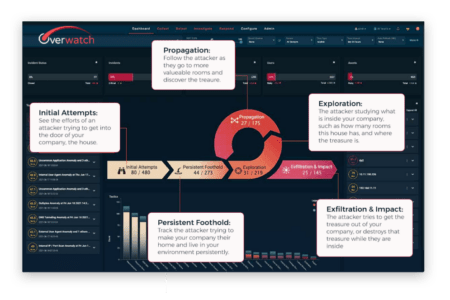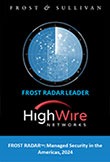It’s often said that cybercriminals never sleep, and neither does their malware. Against this backdrop of 24/7 cyberthreats, the security operations center (SOC) has emerged as a 24/7 solution to combat those threats. Combining the best of human and machine intelligence, SOCs are essential combinations of front-line defense management and command-and-control centers for businesses worldwide. Still, despite their prominence in the emerging cybersecurity landscape, exactly what a SOC is – and how it operates – is a frequent source of confusion. This primer can help you understand the role of a SOC and how managed SOC services help businesses reduce cyber risk and bolster cyber resilience.
What is a Security Operations Center (SOC)?
A security operations center (SOC) is a facility used to monitor and respond to security threats. A SOC may be part of a larger organization or company or a standalone unit. SOCs are typically staffed by security professionals who work to identify, track, and resolve security incidents.
SOCs typically use a combination of technology and human expertise to monitor for security threats. This may include the use of security information and event management (SIEM) tools, intrusion detection systems (IDS), threat intelligence and other forms of monitoring. SOC staff may also proactively search for potential security threats using various methods, such as social media monitoring, dark web intelligence, and open-source intelligence.
SOC Framework and Process
Common SOC framework/process components include:
- Monitoring: Monitoring activity is the most basic function of a SOC, intending to determine if a threat has occurred. But visibility and accessibility are keys to its success; SOCs can only monitor what they see. To be effective, a SOC needs a complete view of the company’s threat landscape. Automated tools, including those which use AI or machine learning, can help and give human analysts a top-level view.
- Analysis: With 24/7 monitoring, a SOC can be put on notice almost immediately of any suspicious activity. If the tools flag a potential threat and raise an alert, the SOC team will look closely at the data to determine the threat’s validity. If it’s a false alarm, it’s discarded. Actual threats are triaged according to how aggressive they are perceived to be and what, in fact, they may be targeting. An advantage of using AI-powered tools is their ability to learn from these incidents to help determine the validity of future, similar threats–helping to make the monitoring process and workflow more efficient.
- Incident Response and Remediation: Of course, incidents may happen. The power of the SOC is recognizing the threat and taking swift, appropriate action. For example, a compromised device requires a different response than a systemwide ransomware attack. SOC analysis helps organizations pinpoint vulnerabilities, adjust monitoring and deploy different tools, if needed. Incident response comes into play to mitigate and remediate potential damage. This remediation may be automated and occur in real time.
- Auditing and Logging: The SOC collects, maintains and views the logs of all network and communications activity across the entire business. Again, the SOC needs to have full visibility to see the entire picture but having this data in hand accomplishes several things. It helps the SOC team determine and define what activities are typical to that organization and what activities deviate from the baseline. Also, it can be used to verify compliance and to document the response as part of a post-event assessment.
- Threat Hunting: As attackers become more businesslike and sophisticated in their methods, cyberattacks are becoming more frequent and more advanced. Proactive monitoring can flag potential attacks in the early stages or before they happen; even when systems are operating normally, there is still work for the SOC to do. Threat hunting works in tandem with proactive monitoring and is just what it says: it’s a process to seek out the bad actors before they successfully attack an organization. It’s a multi-pronged approach that analyzes threat intelligence from the outside environment (other SOC customers, events in the headlines, etc.) to determine patterns of attack and possible vulnerabilities. Part detective work, part profiling and always vigilant, threat hunting helps organizations stay a step ahead.
Secure Operations Center Benefits
Major SOC benefits include:
-
24/7 monitoring and cybersecurity protection
As we mentioned earlier, cyberthreats don’t sleep. Neither should your cybersecurity.
-
Cyberthreat prevention
Cutting-edge SOCs can hunt down threats and prevent many of them from happening in the first place.
-
Cyber incident response and remediation
The whole premise of cyber resilience is to assume that, no matter how potent your cybersecurity is, some threats will break through. In this light, fast and effective remediation is essential to keeping your operations running, even during an incident.
-
Access to Cybersecurity Expertise
Perhaps nowhere is the IT skills shortage felt more acutely than when it comes to cybersecurity. SOC services provide access to this invaluable talent.
-
Lower Cybersecurity Management and Breach Costs
SOC services lower the costs of breaches through avoidance and containment. They also reduce operating and management costs, particularly for. They also help you avoid or reduce costs associated with reputation damage from cyber incidents.
-
Single Pane of Glass
Too many data points from various solutions can cause “analysis paralysis” and possibly confusion. SOC services will unify multiple sources into a single report with actionable alerts or, if desired, respond on your behalf.
-
Compliance
SOC services can help you meet compliance and regulatory standards.
Outsourcing SOC
Like most managed security services, most companies outsource their SOC operations to lower (or avoid high) costs and gain access to high-value expertise. Outsourced SOC also can provide access to more robust security and response technology than most organizations can achieve on their own.
Managed SOC and SOC as a Service (SOCaaS)
As discussed, the cyberthreats facing organizations are more pervasive than ever before. But launching a full-scale SOC can be costly and challenging. In response, many organizations have turned to managed SOC, or SOC as a Service (SOCaaS). This subscription-based offering provides access to external cybersecurity experts who can monitor your logs, devices, cloud environments, and network for known and evolving threats.
By outsourcing this critical function, organizations can reduce their cyber risk and minimize downtime in the event of an incident. In addition, a managed SOC can help organizations to build cyber resilience by providing access to best-in-class tools and processes. As cyberthreats continue to evolve, managed SOC services can offer peace of mind and ensure that your organization is prepared to respond quickly and effectively.
Managed SOC Services
Managed SOC services should cover vital security and compliance needs. Next-generation SOC solutions tackle cyberthreats and compliance needs at the user, network, compliance and Internet levels. An enhanced solution set, such as the one provided by High Wire Networks, should include:
- Users
- Behavior analysis
- Active directory monitoring
- Integration with Office 365 and G-suite
- Network
- Encrypted logs and storage
- Numerous intelligence feeds
- Real-time automated remediation
- Asset discovery
- Compliance
- Policy templates
- Incident response
- Reports
- Documents
- Auditor access
- Internet
- Content filtering
- DNS reports
Managed SOC Benefits
Managed SOC services provide organizations with the cyber resilience they need to minimize downtime and protect critical data in the event of a cyberattack. Benefits include all the benefits of:
- All the benefits of operating a SOC (see above), including:
- improved detection and response times to cyberthreats
- reduced false positives and false negatives
- increased visibility into the cyber threat landscape
- improved efficiency and performance of security teams
- enhanced cyber security posture
- Instant access to SOC-level services
- SOC-level protection that scales with your company
- Access to world-class talent on-demand
Is Managed SOC the same as MDR?
Managed detection and response (MDR) is sometimes confused with managed SOC. They’re related but not the same thing. MDR is a service, not a technology per se, and defined by your security goals. SOC services are essential to MDR and other managed security services, such as network detection and response (NDR), and endpoint protection and response (EDR). MDR’s more robust counterpart, extended detection and response (XDR), broadens the scope of detection and is vendor-agnostic so you can pick the security tools that work for your organization.
Managed SOC Pricing
Managed SOC pricing can vary greatly depending on needs. Commonly, however, pricing models are based on devices or users and service tiers. Variables that impact pricing often include response time, proactivity, logging and reporting, automated vs. human threat hunting, user profiling, and more.
Why Overwatch Managed SOC By High Wire Networks
The team at High Wire Networks brings 20 years of experience to its Managed SOC solutions, delivering the experience and dependability MSPs need for their customers. We’re also an innovator in cutting-edge security tools like artificial intelligence, machine learning and automated remediation. All in, you can deliver your customers a holistic security platform that meshes the best human expertise with the best security machine-based intelligence to provide world-class security solutions that are up to today’s complex challenges.
And when you work with High Wire, you have instant access to a dedicated and proven channel team that can help you plan, establish and deliver those solutions to your clients.









Leave a Reply